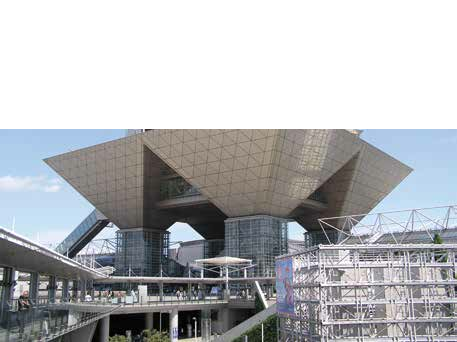Issue:

The city government’s plan to turn Tokyo Big Sight into a media center has the exhibition industry seeing red ink.
AFTER WEATHERING ALLEGATIONS OF brown envelopes changing hands, massive cost over-runs, plagiarism and breaches of contract over the construction of facilities, the organizers of the 2020 Tokyo Olympic Games might have hoped that the bad news was behind them. Now the Tokyo Metropolitan Government (TMG) finds itself at the center of a three-way collision pitting the city against the lucrative exhibitions industry and the world’s media.
The TMG decided to close Tokyo Big Sight, the city’s prime exhibition and event venue, so it can serve as the international media center before and during the 2020 Olympics and Paralympics. The exhibitions sector claims that the decision is “insane” and will cost the city dearly in the long run.
Speaking at the annual meeting of the Japan Exhibition Association (JEXA) on Jan. 12, Chairman Tad Ishizumi compared the decision to the disaster wrought on the industry by the earthquake/tsunami/nuclear disaster of March 2011, which hit the industry hard as exhibitors and visitors stayed away from the country.
“For enterprises, especially small and medium-size enterprises, this is nothing less than a matter of life and death,” he said. “Even when exhibitions were cancelled for just one month in 2011, many companies were on the verge of bankruptcy. Imagine what the impact will be if Tokyo Big Sight is unavailable for seven months.”
The industry says the decision means that the largest purpose-built venue of its kind will be unavailable for exhibitions between April and October 2020, forcing the cancellation or significant down-sizing of 170 exhibitions that are held at Big Sight during that period. It will cause an estimated ¥1.3 trillion in financial damages, they claim, with exhibitors losing out on ¥1.2 trillion and service companies forfeiting some ¥100 billion. They add that there are insufficient purpose-built alternatives, with Makuhari Messe also earmarked for sporting events and to provide support to the organizers of the Games.
THE DECISION BY THE city government which owns Tokyo Big Sight also threatens the survival of 38,000 small and medium-size exhibitors that rely on events for a large portion of their annual revenue. It “guts” a 1,000 company-strong local service industry that creates booths, signage, staffing, food and beverage facilities and a host of other services and depends on exhibitions for its existence.
“We organize Comiket, the largest manga and anime event in Japan, at Big Sight every August and many of the companies that take part rely on that exhibition for as much as 50 percent of their annual revenue,” said Hajime Okada, president of Hiroshima-based publisher Eikou Co., Ltd. “To not be able to use the venue for seven months is going to be absolutely devastating to these companies.”
Remarkably, the city government initially proposed to close Tokyo Big Sight for 20 months to carry out upgrades and improvements on the facilities. The exhibitions industry has at least managed to avoid that scenario.
The exhibitions industry is working with the metropolitan government and the Ministry of Economy, Trade and Industry and is marshalling the assistance of a number of friendly members of the Diet to fight in its corner, but the only solution to emerge so far is a plan for the construction of a temporary exhibition hall one quarter the size of the facilities at Big Sight.
“They say this is the solution,” Ishizumi said. “But it’s not. A simple calculation shows that with a temporary venue one quarter the size of Big Sight events can only be one quarter of their previous scale. That means a loss of more than ¥1 trillion in sales.”
A spokesman for the metropolitan government issued a statement confirming that a 23,000m2 facility will be made available nearby between April 2019 and November 2020, but declined to comment on why Big Sight had been selected as the media center, the anticipated scale of economic losses or the possibility that exhibitions will be lost to the city forever because of the decision.
Yuichiro Nishida, director of the Planning and Public Relations Division of Tokyo Big Sight Inc. and presently on secondment to the metropolitan government, also declined to comment on whether the authorities are open to the idea of reviewing the selection and Gov. Yuriko Koike’s position on the matter.
“It is a nightmare,” said Christopher Eve, managing director of UBM Japan Co., which organizes trade shows, and a director of JEXA. “We are a big company so we will survive, but a lot of these companies rely on events at Big Sight, so if there are no trade shows, they have no income, they have to lay off staff and, ultimately, they could go under.”
He added: “And organizers of events that have been using Big Sight for years will find out that they have no venue in 2020 and will probably look at Shanghai, Hong Kong or Singapore as an alternative. And some of them might not come back.”
Julian Ryall is Japan correspondent for the Daily Telegraph.

